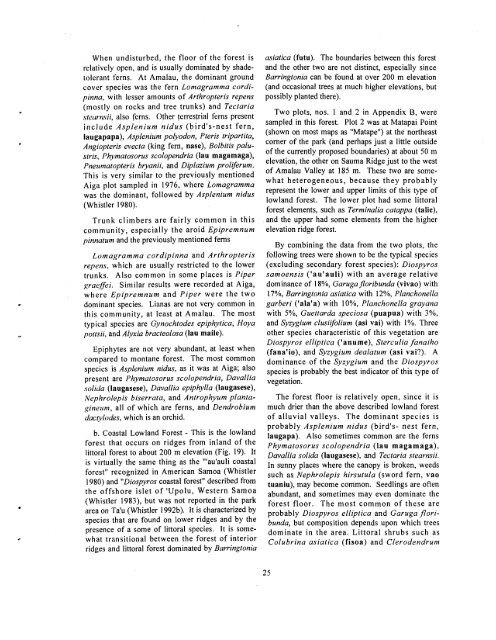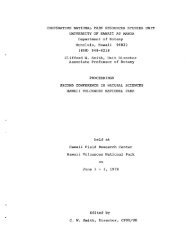american samoa - University of Hawaii at Manoa
american samoa - University of Hawaii at Manoa
american samoa - University of Hawaii at Manoa
You also want an ePaper? Increase the reach of your titles
YUMPU automatically turns print PDFs into web optimized ePapers that Google loves.
When undisturbed, the floor <strong>of</strong> the forest is<br />
rel<strong>at</strong>ively open, and is usually domin<strong>at</strong>ed by shade-<br />
tolcrant ferns. At Amalau, the dominant ground<br />
cover species was the fern Lomagramma cordi-<br />
pinna, with lesser amounts <strong>of</strong> Arthropteris repens<br />
(mostly on rocks and tree trunks) and Tectaria<br />
sfmrrisii, also ferns. Other terrestrial ferns present<br />
include Asplenium nidus (bird's-nest fern,<br />
laugapapa), Asplenium polyodon, Pteris tripartita,<br />
Angiopteris evecta (king fern, nase), Bolbitis palu-<br />
sfris, Phym<strong>at</strong>osorus scolopendria (lau magamaga),<br />
Pneum<strong>at</strong>opteris bryanii, and Diplazium proliferum.<br />
This is very similar to the previously mentioned<br />
Aiga plot sampled in 1976, where Lomagramma<br />
was the dominant, followed by Asplenium nidus<br />
(Whistler 1980).<br />
Trunk climbers are fairly common in this<br />
community, especially the aroid Epipremnum<br />
pinn<strong>at</strong>um and the previously mentioned ferns<br />
Lomagramma cordipinna and Arthropteris<br />
repens, which are usually restricted to the lower<br />
trunks. Also common in some places is Piper<br />
graeffei. Similar results were recorded <strong>at</strong> Aiga,<br />
where Epipremnum and Piper were the two<br />
dominant species. Lianas are not very common in<br />
this community, <strong>at</strong> least <strong>at</strong> Amalau. The most<br />
typical species are Gynochtodes epiphytica, Hoya<br />
pottsii, and Alyxia bracteolosa (lau maile).<br />
Epiphytes are not very abundant, <strong>at</strong> least when<br />
compared to montane forest. The most common<br />
species is Asplenium nidus, as it was <strong>at</strong> Aiga; also<br />
present are Phymafosorus scolopendria, Davallia<br />
.solids (laugasese), Davallia epiphylla (laugasese),<br />
Nephrolepis biserr<strong>at</strong>a, and Antrophyum planta-<br />
gineum, all <strong>of</strong> which are ferns, and Dendrobium<br />
dacfylodes, which is an orchid.<br />
b. Coastal Lowland Forest - This is the lowland<br />
forest th<strong>at</strong> occurs on ridges from inland <strong>of</strong> the<br />
littoral forest to about 200 m elev<strong>at</strong>ion (Fig. 19). It<br />
is virtually the same thing as the "'au'auli coastal<br />
forest" recognized in American Samoa (Whistler<br />
1980) and "Diospyros coastal forest" described from<br />
the <strong>of</strong>fshore islet <strong>of</strong> 'Upolu, Western Samoa<br />
(Whistler 1983), but was not reported in the park<br />
area on Ta'u (Whistler l992b). It is characterized by<br />
species th<strong>at</strong> are found on lower ridges and by the<br />
presence <strong>of</strong> a some <strong>of</strong> littoral species. It is some-<br />
wh<strong>at</strong> transitional between the forest <strong>of</strong> interior<br />
ridges and littoral forest domin<strong>at</strong>ed by Barringtonia<br />
asi<strong>at</strong>ica (futu). The boundaries between this forest<br />
and the other two are not distinct, especially since<br />
Barringtonia can be found <strong>at</strong> over 200 m elev<strong>at</strong>ion<br />
(and occasional trees <strong>at</strong> much higher elev<strong>at</strong>ions, but<br />
possibly planted there).<br />
Two plots, nos. 1 and 2 in Appendix B, were<br />
sampled in this forest. Plot 2 was <strong>at</strong> M<strong>at</strong>apai Point<br />
(shown on most maps as "M<strong>at</strong>ape") <strong>at</strong> the northeast<br />
comer <strong>of</strong> the park (and perhaps just a little outside<br />
<strong>of</strong> the currently proposed boundaries) <strong>at</strong> about 50 m<br />
elev<strong>at</strong>ion, the other on Sauma Ridge just to the west<br />
<strong>of</strong> Amalau Valley <strong>at</strong> 185 m. These two are some-<br />
wh<strong>at</strong> heterogeneous, because they probably<br />
represent the lower and upper limits <strong>of</strong> this type <strong>of</strong><br />
lowland forest. The lower plot had some littoral<br />
forest elements, such as Terminalia c<strong>at</strong>appa (talie),<br />
and the upper had some elements from the higher<br />
elev<strong>at</strong>ion ridge forest.<br />
By combining the d<strong>at</strong>a from the two plots, the<br />
following trees were shown to be the typical species<br />
(excluding secondary forest species): Diospyros<br />
samoensis ('au'auli) with an average rel<strong>at</strong>ive<br />
dominance <strong>of</strong> 18%, Garugafloribunda (vivao) with<br />
17%, Barringtonia asi<strong>at</strong>ica with 12%, Planchonella<br />
garberi ('ala'a) with lo%, Planchonella grayana<br />
with 5%, Guettarda speciosa (puapua) with 3%,<br />
and Syzygium clusiifolium (asi vai) with 1%. Three<br />
other species characteristic <strong>of</strong> this veget<strong>at</strong>ion are<br />
Diospyros elliptica ('anume), Sterculia fanaiho<br />
(fana'io), and Syzygium deal<strong>at</strong>um (asi vai?). A<br />
dominance <strong>of</strong> the Syzygium and the Diospyros<br />
species is probably the best indic<strong>at</strong>or <strong>of</strong> this type <strong>of</strong><br />
veget<strong>at</strong>ion.<br />
The forest floor is rel<strong>at</strong>ively open, since it is<br />
much drier than the above described lowland forest<br />
<strong>of</strong> alluvial valleys. The dominant species is<br />
probably Asplenium nidus (bird's- nest fern,<br />
laugapa). Also sometimes common are the ferns<br />
Phym<strong>at</strong>osorus scolopendria (lau maga maga),<br />
Davallia solida (laugasese), and Tectaria stearnsii.<br />
In sunny places where the canopy is broken, weeds<br />
such as Nephrolepis hirsutula (sword fern, vao<br />
tuaniu), may become common. Seedlings are <strong>of</strong>ten<br />
abundant, and sometimes may even domin<strong>at</strong>e the<br />
forest floor. The most common <strong>of</strong> these are<br />
probably Diospyros elliptica and Garuga j70ri-<br />
bunda, but composition depends upon which trees<br />
domin<strong>at</strong>e in the area. Littoral shrubs such as<br />
Colubrina asi<strong>at</strong>ica (fisoa) and Clerodendrum
















